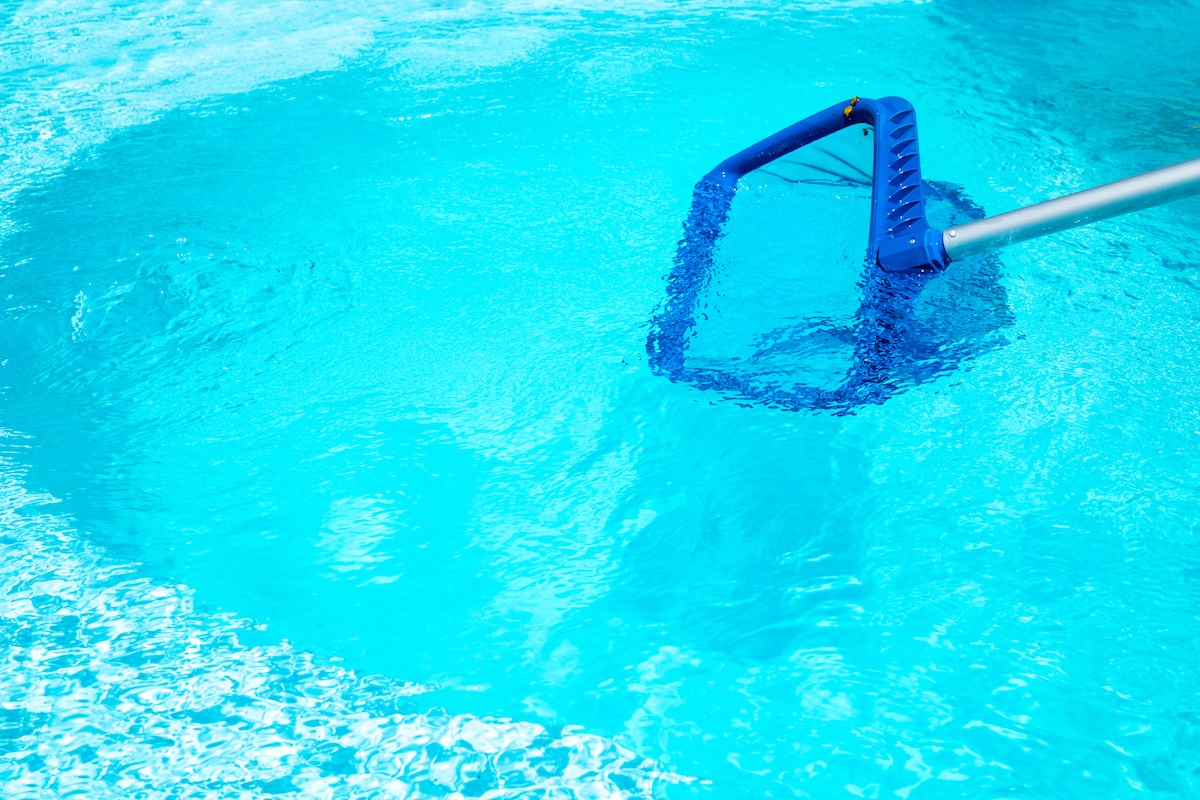So, you’ve got a pool—or maybe you’re considering taking the plunge. Either way, it’s a great idea—they’re a perfect way to cool off, entertain, or just enjoy some peaceful time by the water. But as any experienced pool owner will tell you, there’s more to it than just dipping your toes in whenever you feel like it. Sure, you might have that picture-perfect image of lounging by a Las Vegas pool with a drink in hand, and that’s part of the dream. But, like any dream worth having, it comes with a little responsibility.
If you think about it, managing a swimming pool is basically managing a small ecosystem. And I’m not saying that to sound dramatic—it’s just the reality.
When you’re talking about a body of water exposed to the elements—i.e. the Clark County sun—it doesn’t take much for things to get out of balance. A little neglect, and you could find yourself having to deal with cloudy/murky water, pool algae removal, having to drain the pool entirely—or worse.
That’s not to say it’s a burden—far from it. With the right routine and care, it’s more about keeping things steady than constantly fixing problems. And once you’ve got a rhythm, it’s pretty straightforward. A well-maintained pool can easily stay clean and enjoyable, giving you that idyllic spot you envisioned in the first place. So yeah, it’s a bit of a balancing act, but it’s worth every bit of effort.
Let’s dive into what it really takes to keep your pool clean, safe, and fun—so you can spend more time relaxing and less time worrying about upkeep.
Pool Circulation
Circulation is very important. If water doesn’t keep moving, you’ll end up with all sorts of nasty problems, like pests, algae, or an overall look of cloudy pool water. Circulation keeps things healthy.
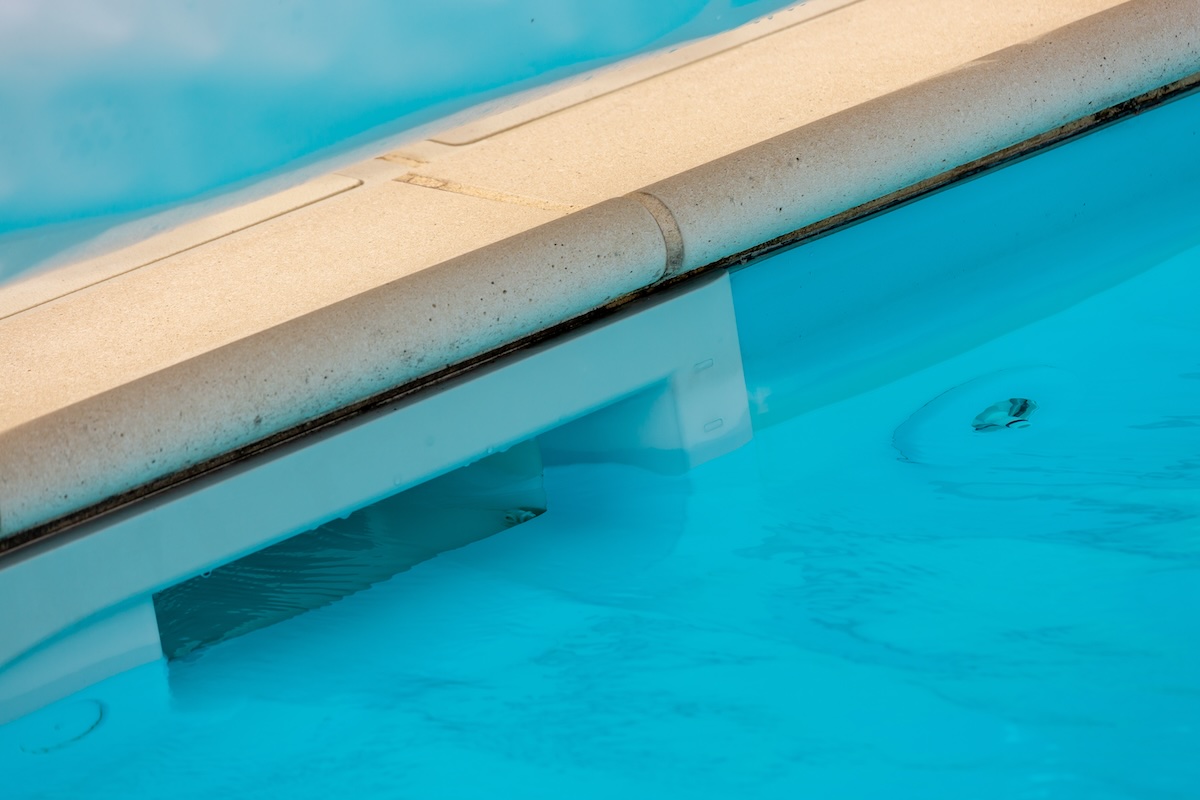
To get this right, your pool jets should be angled about 45 degrees away from the pump. This angle creates a circular motion that keeps the water moving consistently, preventing areas of stillness where debris can settle or algae can take root. Without that flow, you’ll start noticing “dead spots,” especially around the stairs or behind ladders, where things tend to accumulate and grow if left unchecked.
Run the pump 8 to 12 hours a day during swim season. That may sound like a lot, but if the water isn’t moving, it’s a breeding ground for things you don’t want anywhere near your pool. If you cut corners on the daily pump running time, you’ll notice the water getting murkier, and before long, you’ll have an algae bloom or worse—mosquitoes making themselves right at home.
Pro Tip: Yes, mosquitos can crash your pool party even here in Las Vegas! Skip on running the pump, and your swimming pool becomes a mosquito magnet—an oasis in the middle of the desert just waiting for them to settle in. Keep the water flowing, and you’ll show them the door before they even unpack their bags.
Even with good pool circulation, you’ll want to remember to regularly brush off areas where water tends to stagnate—around steps, ladders, and right under the skimmer. By brushing these areas at least once a week, you’ll break up any buildup before it becomes a full-blown algae bloom, which is not only unsightly, but also time-consuming to treat. If you’re short on time or prefer to leave the maintenance to the pros, a weekly pool cleaning service can make sure these critical areas get the attention they need to prevent algae blooms—like the one pictured below:
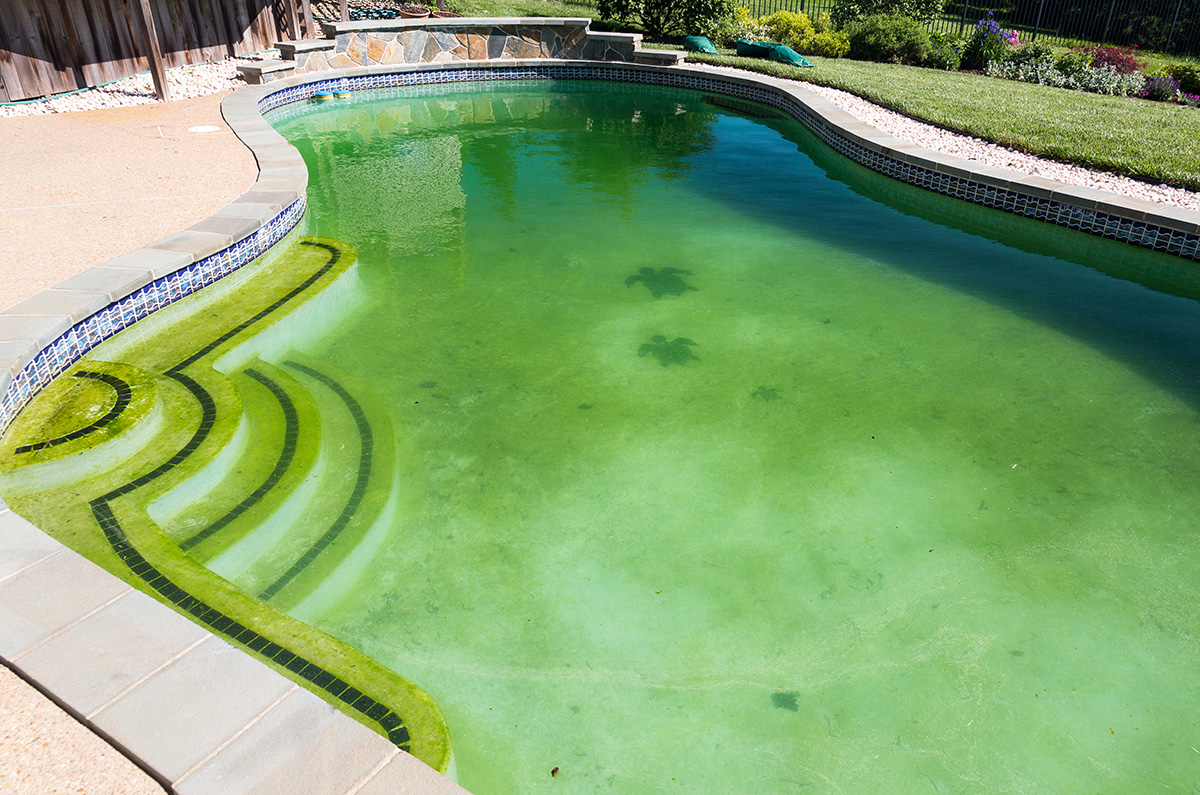
Standard Pool Cleaning Schedule
Let’s not sugarcoat it—owning a pool requires work. But once you get into a groove, it’s really not too bad.
- Start with the basics: skimming the surface daily. You’ll be amazed at how fast leaves, bugs, and all sorts of other floaters show up. Do this regularly, and you’ll avoid clogged filters later.
- The skimmer basket (you know, the thing that catches all the junk) needs to be emptied at least once a week too. And while you’re at it, check the filter. Clogged filters equal poor circulation, and we’ve already established why that’s bad news.
- Then, brush the walls and floor of the pool once or twice a week. This is one of those tasks that might seem like overkill—but algae loves to cling to surfaces, and if you don’t stay on top of it, you’ll be spending hours scrubbing when you could have been done in ten minutes.
- Vacuuming is the next step, whether it’s a manual vacuum or an automatic one that roams around the pool for you. Aim for once or twice a week, depending on how much use your pool gets.
If that schedule sounds like a lot to manage, or if you just don’t have the time to stay on top of all those tasks, it might be worth considering a professional pool cleaning service. While it’s completely doable to keep your pool in good shape on your own, a pool cleaning service takes the weight off your shoulders. They’ll handle everything from skimming and vacuuming to maintaining the right chemical balance, so you don’t have to worry about it.
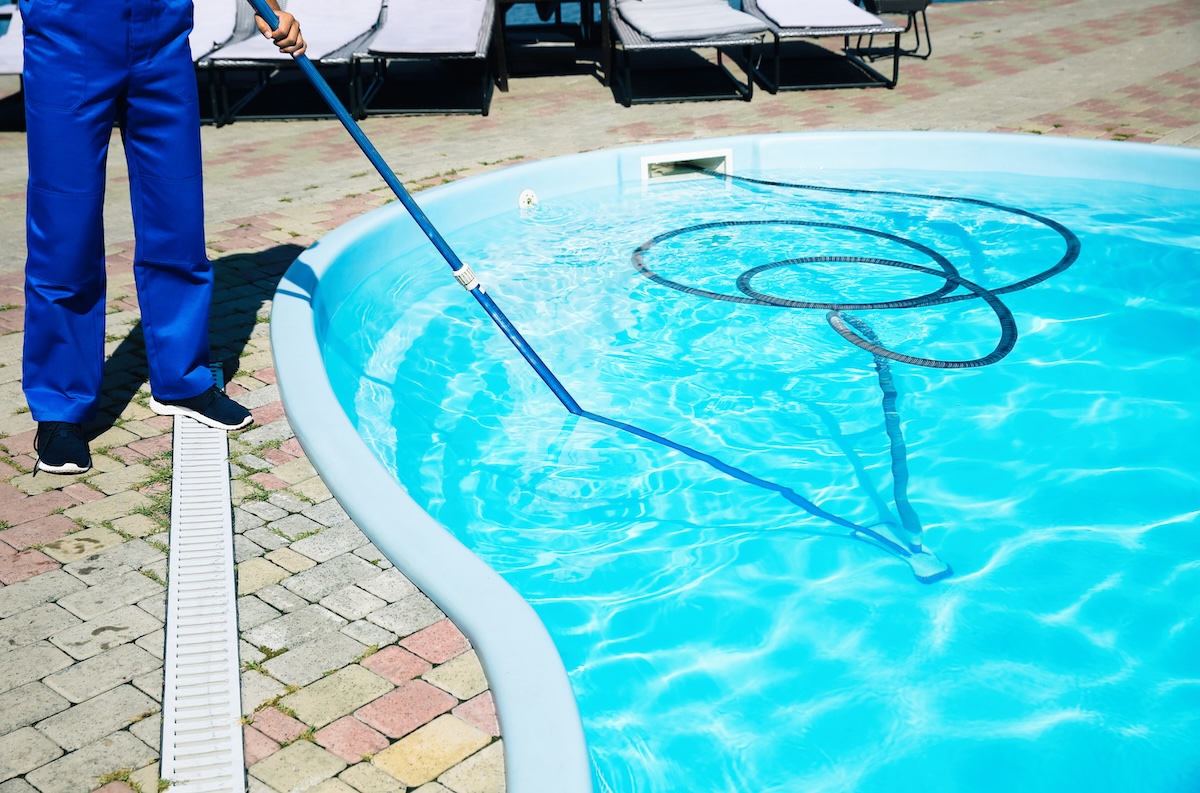
Professional pool cleaners have the experience to spot potential problems before they become big headaches—things like equipment malfunctions, leaks, or imbalances in your water chemistry. They can set up a routine that works for your pool’s specific needs and save you a lot of time and effort, especially if you’d rather spend that time enjoying the pool instead of cleaning it. If peace of mind and convenience are priorities, letting the professionals take over might be the best way to keep your pool clean and pristine without the hassle.
Of course, if you’re a homeowner, you can absolutely handle pool maintenance yourself. Some pool owners take pride in keeping their pool clean and balanced, and once you get into a routine, it can be manageable.
That said, it’s a big commitment—there’s a reason pool ownership comes with a learning curve—especially here in Las Vegas. Between keeping up with skimming, brushing, vacuuming, and balancing chemicals, it’s easy to fall behind if you have other things you need to think about besides pool maintenance.
If you’re the type who enjoys a bit (or a lot) of DIY work and doesn’t mind putting in the effort, go for it—but it’s definitely a time investment, and there’s always the chance you’ll miss something that could turn into a bigger issue down the line. If you’re in the Clark County area, you might consider hiring a Las Vegas pool cleaning service.
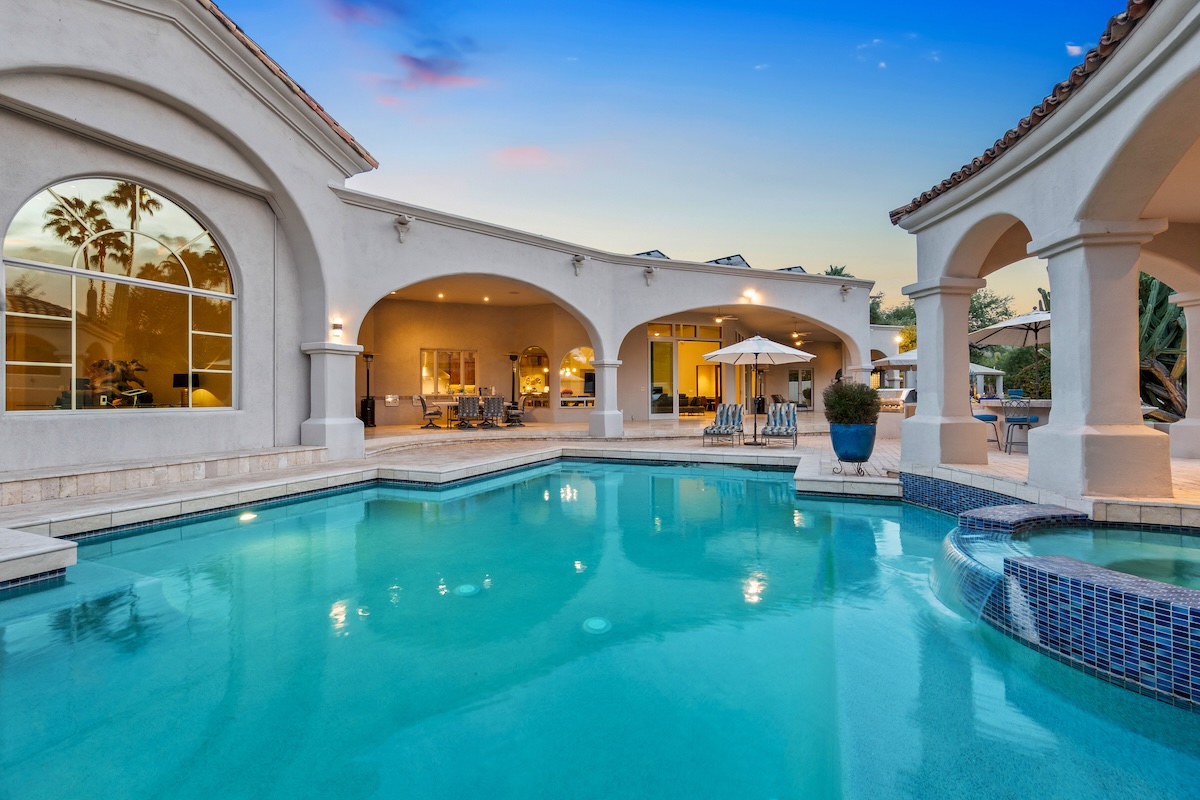
Pool Chemistry
Pool Chemistry refers to the balance of chemicals in pool water that maintain safe, clean, and comfortable swimming conditions. It includes monitoring pH levels, alkalinity, calcium hardness, and sanitizer levels (such as chlorine) to prevent bacteria, algae, and water quality issues.
It’s the part of pool maintenance that makes a lot of pool owners nervous, but honestly, once you get the hang of it, it’s simple.
- Test your water weekly. There are kits for this that make it easy—just dip a strip in, compare colors, and boom, you’ll know what needs adjusting. Your pH levels should stay between 7.2 and 7.8. Too high, and you’re looking at cloudy water and scaling. Too low, and your swimmers (and pool equipment) won’t be happy.
- Alkalinity is next. You want that in the 80 to 120 parts per million (PPM) range. This acts as a buffer for the pH, helping keep everything balanced. Then there’s calcium hardness—shoot for 200 to 400 PPM. Too much calcium can cause scaling, while too little makes the water “aggressive” and can damage your pool surfaces.
- And of course, there’s chlorine—the thing that keeps your pool from turning into a petri dish. You generally want your chlorine levels between 1.0 and 3.0 PPM.
Pro Tip: Chlorine can come in various forms—liquid, tablets, or granules. Don’t just throw chlorine in whenever—you’ll need to test your water regularly to make sure the levels are where they should be. If your pool gets a lot of sun or heavy use, you might need to add chlorine more frequently.
Local Tips for Las Vegas Pool Maintenance
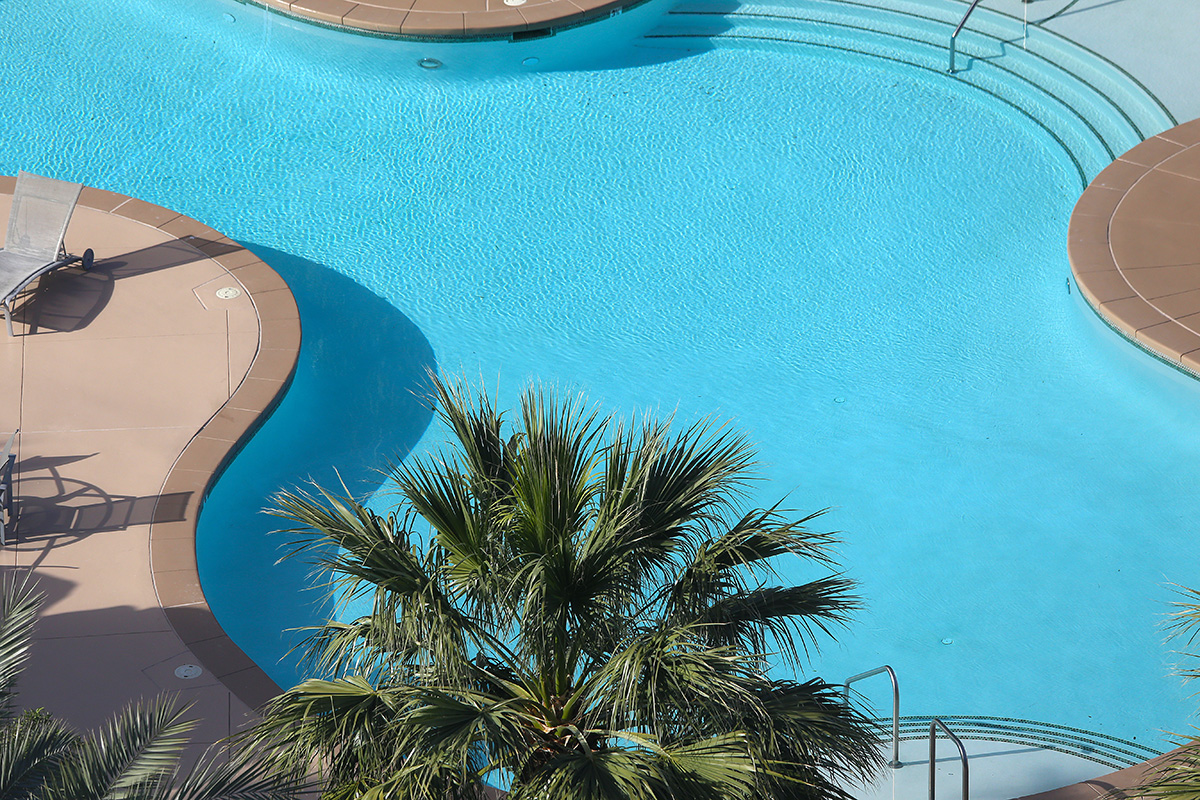
Pool chemistry in Las Vegas comes with its own set of unique challenges, thanks to the desert climate, high evaporation rates, and hard water. If you’re maintaining a pool in the Vegas area, you’ll have to be a little more vigilant about certain things—especially when it comes to calcium hardness, pH levels, and the effects of constant sunlight.
Las Vegas’ temperatures regularly soar above 100°F, and that intense heat can wreak havoc on your pool chemistry. The sun’s ultraviolet (UV) rays burn off chlorine quickly, meaning your chlorine levels can drop much faster than in milder climates. You’ll often find yourself adding chlorine more frequently to keep the water sanitized.
Pro Tip: This also makes regular water testing a must—especially after a hot stretch or a period of heavy use. You might also consider using a chlorine stabilizer (also called cyanuric acid), which helps protect chlorine from UV degradation.
With such dry, hot air, the water in your pool also evaporates faster than in many other parts of the country. As the water evaporates, the concentration of dissolved minerals in the remaining water increases. This is why you might notice pH levels creeping higher more often than expected in a Las Vegas pool. A high pH (above 7.8) reduces chlorine’s effectiveness, which could lead to cloudy water or algae if left unchecked.
The key is to stay on top of your pH levels. Test frequently, and if the pH starts climbing, you’ll need to add a pH reducer (usually muriatic acid) to bring it back into the ideal range of 7.2-7.8. Since you’re also dealing with alkalinity, it’s important to keep that in the 80-120 PPM range to help stabilize the pH and avoid wild swings.
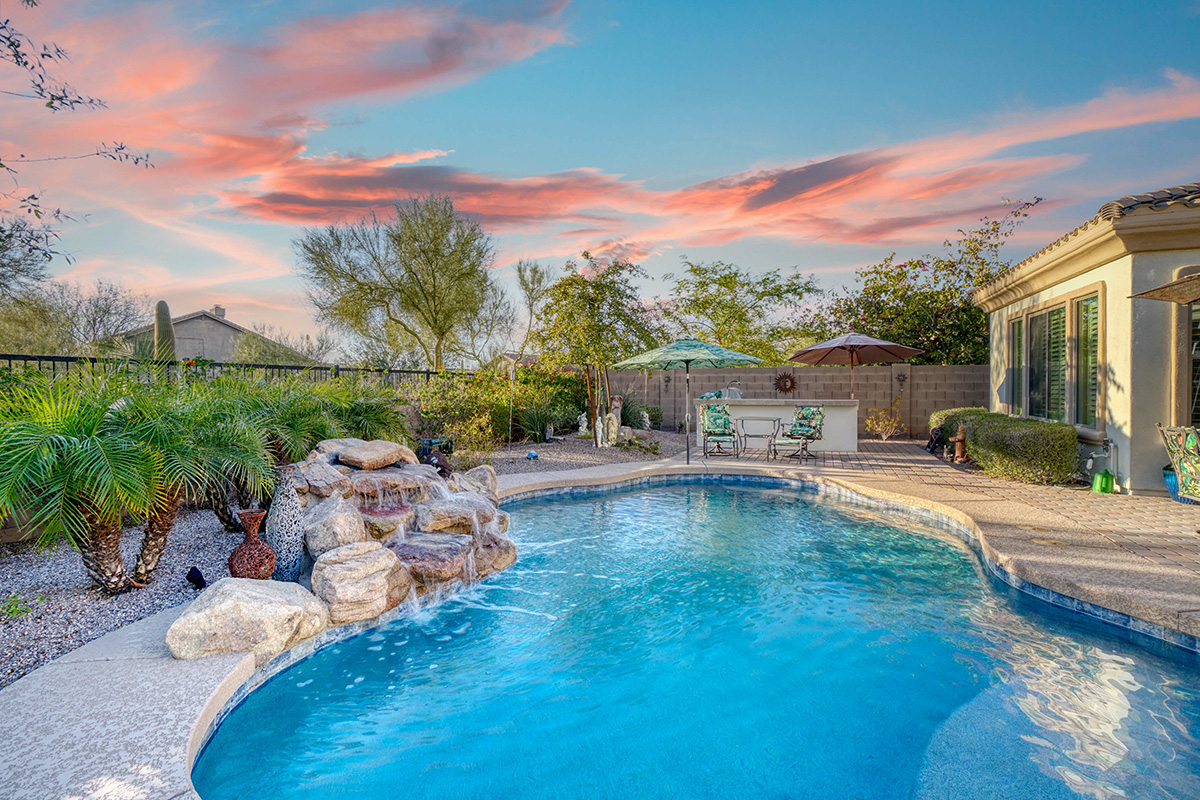
One of the biggest concerns for pool owners in Las Vegas is dealing with hard water. In fact, Vegas has the 2nd hardest water in the entire country. Our city’s water supply is naturally high in calcium, which is great for drinking water but not so great for your pool. Calcium hardness in the desert can easily creep above the recommended 200-400 PPM range, leading to scaling. You’ll see this as a white, chalky buildup on your pool surfaces, tiles, and even inside your pool equipment. It can also lead to cloudy water if the calcium levels get too high.
With Las Vegas’ dry conditions, your pool loses a lot of water to evaporation, and when you replace it, you’re adding fresh water filled with more minerals like calcium. So, over time, this cycle of evaporation and refill can lead to high mineral content in the pool, requiring regular adjustments to pH and calcium levels.
Pro Tip: You’ll likely be topping off the pool frequently, but make sure to test the chemistry afterward because even a few inches of new water can change your pH and calcium levels. Installing a pool cover when the pool is not in use can help cut down on evaporation, which in turn will slow down the buildup of minerals in the water.
How Do You Manage All This Without Going Crazy?
Here’s where many pool owners get tripped up—there’s a lot to keep track of, right? If you follow a regular testing and adjustment schedule, it becomes second nature. Some pool owners find a routine that works for them, whether it’s testing once a week or every few days depending on the season and pool use.
If all this sounds like more hassle than you’d like, hiring a professional pool service may be a better option. They’ll handle the water testing, the adjustments, and make sure everything stays balanced. It’s like outsourcing the chemistry so you can focus on enjoying the pool, instead of worrying about it.
Owning a pool in Las Vegas is a luxury, but the desert heat, hard water, and constant evaporation make pool maintenance more challenging than it seems. With the intense sunlight quickly burning off chlorine, rising pH levels from rapid water loss, and scaling issues from high calcium, keeping your pool water chemistry balanced can feel like a full-time job. Hiring a professional pool service takes the guesswork out of the equation, making sure your water stays crystal clear and safe to swim in, while you focus on enjoying your pool instead of constantly testing and managing it.
In the end, pool chemistry is all about balance—keeping things in that sweet spot so your pool stays clean, clear, and safe for swimming. Once you understand the basics, it’s not the nightmare it seems. But if you’d rather let someone else deal with the science, that’s what the pros are for.
Tools of the Trade
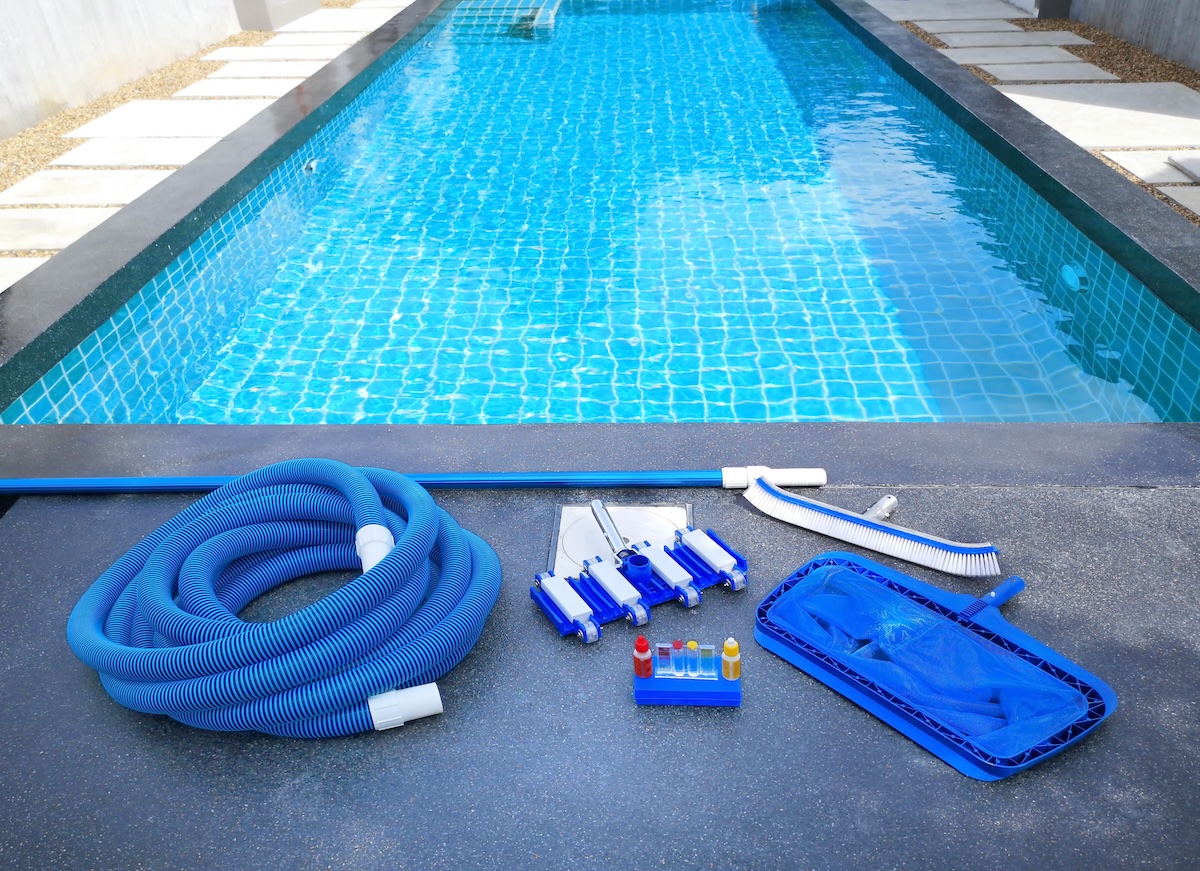
If you’re going to keep your pool clean and well-maintained, you’re going to need some gear. Here are the basics:
- A telescopic pole with a skimmer net attachment is a must-have. It helps you reach the far ends of the pool without falling in.
- Attach a brush to that same pole for scrubbing walls and steps.
- Whether it’s manual or automatic, a pool vacuum is essential for getting rid of debris that settles at the bottom.
Don’t forget the chemicals: test kits, pH adjusters, chlorine, and an algaecide for those times when you start seeing the green stuff.
Troubleshooting Common Pool Issues
Troubleshooting pool problems is one of those things you hope to never have to do, but chances are, you will.
It’s like owning a car—no matter how much you baby it, there’s always something that’ll crop up eventually. And when it does, you’ll want to be ready.
Cloudy water, algae, and discoloration are the common issues that pop up in pool ownership, but if you or your pool service know what to look for, you can stop those issues before they snowball into a disaster.
Fixing Cloudy Water
Cloudy water can be caused by a lot of different things, so you (or your professional pool cleaner) have to be a bit of a detective. If your pool turns from crystal clear to murky, don’t panic—it’s frustrating, but fixable.
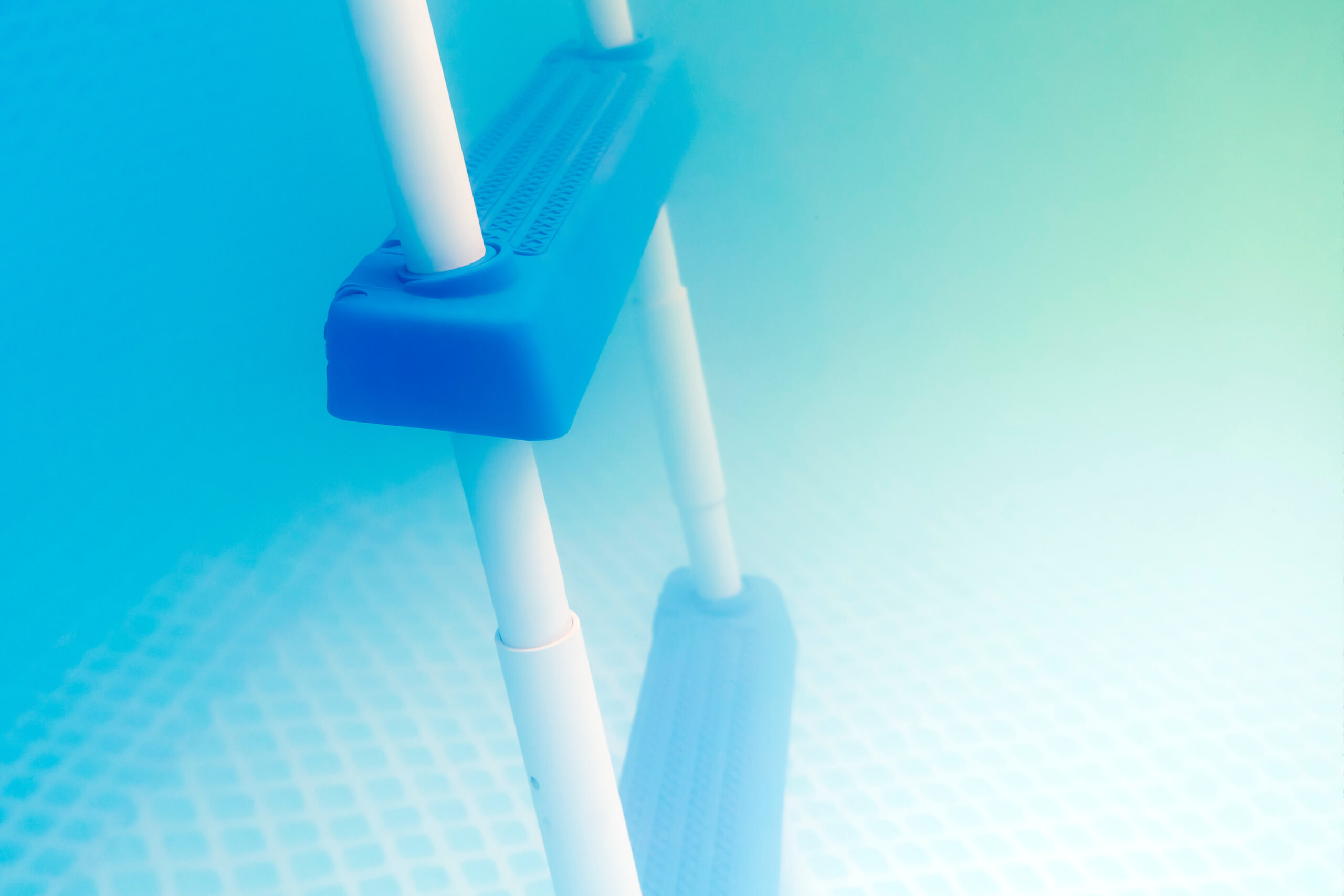
Most of the time, cloudy water is a sign that your filters are clogged. Your filter system is constantly removing debris, particles, and anything else that doesn’t belong. If it’s backed up, you’re not getting the circulation you need, and the result is cloudy water.
Circulation issues also cause cloudiness. If your pump isn’t running enough hours a day (remember that 8-12 hour rule during swim season), or if the jets aren’t angled properly to keep the water moving, you’ll end up with stagnation.
Pro Tip: Water should constantly flow, so if something feels off, check your pump and adjust the angles of the jets. You want that water to move in a circular pattern throughout the pool.
There’s also water chemistry to consider. If your pH or chlorine levels are out of whack, cloudy water can be one of the first signs. A good test kit can tell you if your pH has spiked too high (above 7.8), or if your chlorine has dipped too low (under 1.0 PPM). Either way, adjusting your chemicals back to the proper range is a must.
And here’s another tip: If you’ve been using your pool a lot lately, especially with lots of sunscreen and sweat getting in there, cloudiness might just be the water telling you it’s time for a deep clean. When people swim in the pool frequently—especially with sunscreen, sweat, and other oils getting into the water—it can build up and affect the water clarity. It can overwhelm the pool’s filtration system, and even throw off the chemical balance. So when the water starts looking cloudy after heavy use, it could be a sign that the pool needs a good deep cleaning and possibly some chemical adjustment.
Algae
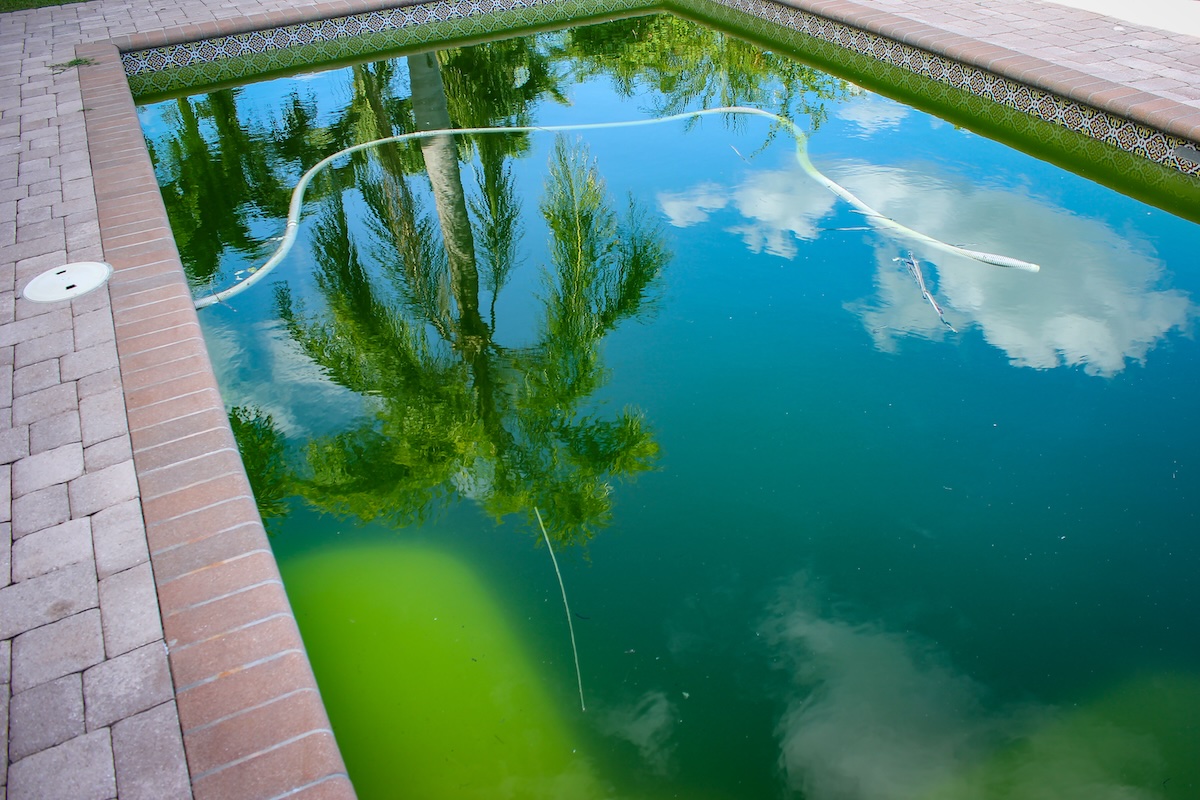
Algae is like the pool equivalent of mold in your bathroom. It’s disgusting, stubborn, and it feels like it shows up overnight, just waiting to ruin your weekend. But if you ignore it, it only gets worse.
Once you see those green, black, or mustard-colored patches, it’s time to go to war.
The first line of defense against pool algae is regular brushing—grab your pool brush and scrub the walls and floor like you’re trying to erase every last trace of it. Algae clings to surfaces, so it’s not enough to just float around and vacuum up the debris. You’ve got to break it up at the root.
Next up is vacuuming. Whether you have a manual or automatic pool vacuum, run it through the entire pool. Get every inch, because if you miss a spot, that algae can and will come back.
Pro Tip: Algae has a way of hiding, so even if it looks like you got it all, double-check the corners and hidden nooks: steps, behind ladders, and under any floaters or toys that might have been sitting out too long. Remember that algae thrives best in shady, undisturbed areas.
Once you’ve done the heavy lifting, it might be time for shock treatment. Pool shock involves hitting the water with a large dose of chlorine—way more than you’d normally use—to kill off the algae. It’s best to do this in the evening or at night, because sunlight reduces chlorine’s effectiveness, and you’ll want that chlorine working at full strength.
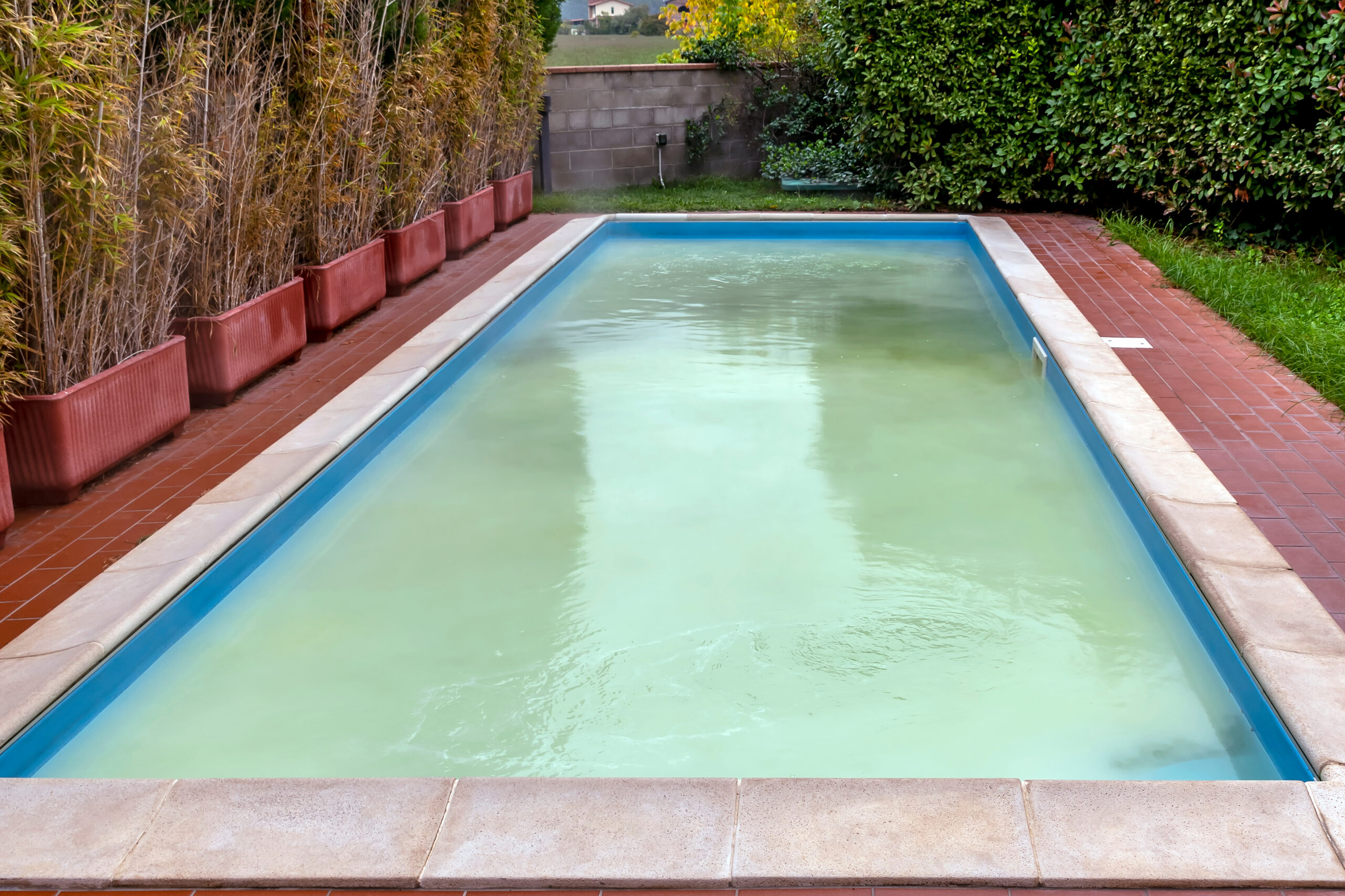
Finally, follow up with an algaecide. It’s like the cherry on top of your algae-killing sundae—it helps prevent any algae spores from making a comeback. Algaecide works as a backup defense, so while it might not always be necessary, it’s a good insurance policy to keep algae at bay for the long term. (Think of it as a preventative measure rather than a cure.)
Discolored Water (A.K.A. “That’s Not Algae”)
Discolored water that’s not algae-related can be a bit of a head-scratcher for many pool owners. If your pool water has a greenish tint and it’s not algae, or if it’s got a red, brown, or even blue or purple hue, you’re likely dealing with metal contamination.
Copper, iron, and manganese are the usual culprits, and these can sneak into your pool water in several ways. It could be because your local water supply has higher mineral content, or it could be that some pool equipment is corroding. Either way, it’s not something you can brush away.
Copper: The Greenish or Bluish Tint
Copper is one of the most common metals found in pool water, and it can turn your pool a surprising shade of green or even blue. A lot of people mistake this for algae because of the green hue, but here’s how you can tell the difference: Algae tends to cling to surfaces and has a slippery, slimy feel, while copper just changes the water color without any noticeable growth on the pool walls or floor.
Copper can sneak into your swimming pool water from a few places:
- Source Water: If your water supply has a high copper content (which can happen if your local water source has old copper pipes), the metal can leach into your pool.
- Pool Equipment: Corrosion of copper heat exchangers or plumbing can also introduce copper into the water.
- Chemicals: Overuse of copper-based algaecides can lead to an excess of copper in the pool.
If you notice a greenish tint, you can try to test your water for copper. Levels of copper should stay under 0.2 parts per million (PPM) to avoid discoloration. Anything above that, and you’ll start seeing the water change colors. You’ll need a metal sequestrant to bind the copper and prevent staining.
Iron: The Reddish, Brownish, or Yellow Tint
Iron in your pool water is another troublemaker. If you see water turning reddish, brownish, or even yellow, iron is probably the culprit. This often happens after adding new water to your pool, especially if your water source has a high iron content (like well water).
Iron tends to oxidize when it hits the chlorine in your pool, which is why you’ll suddenly see a shift in color. It can range from a slight yellow tint to a full-on rust-brown, depending on how much iron is present. Iron can also leave nasty stains on your pool surfaces if it isn’t dealt with.
To get rid of iron, you may want to:
- Use a Sequestrant: This will bind the iron in the water and prevent it from causing stains or further discoloration.
- Test Your Water Source: If iron is consistently an issue, you may want to install a filter for your fill water to reduce the iron content before it even gets into your pool.
Manganese: The Pink, Purple, or Black Tint
Manganese is less common, but can still cause some weird color changes in your pool. It usually turns water pink or purple (which can be quite a shock) or, in higher concentrations, it can even give the water a blackish tint. Manganese often enters the pool from well water or certain municipal water sources, particularly in areas with high natural mineral deposits.
Manganese, like iron, oxidizes when it reacts with chlorine, leading to these dramatic color shifts. You’ll need to handle manganese with a sequestrant to keep it from staining your pool.
Calcium: Cloudy, White or Gray Tint
Calcium is a little different because it doesn’t cause a color change so much as it makes the water cloudy or hazy. If you notice a milky, grayish tint, high calcium levels could be to blame. It’s particularly common in areas with hard water like Las Vegas. Over time, too much calcium can also lead to scaling on your pool surfaces, which is rough and hard to remove.
To avoid calcium buildup:
- Keep Your Calcium Hardness in Check: It should be between 200-400 PPM. Anything higher, and you’ll start seeing that cloudy effect.
- Partially Drain and Refill Your Pool: This dilutes the calcium concentration if it’s gotten out of hand.
What To Do When You See These Colors
When you see your pool water start turning strange colors, it’s tempting to jump in and try to fix it yourself. However, discolored water from metals like copper, iron, or manganese can be tricky to diagnose and treat. Basic pool test kits often won’t tell you what you need to know, and even if you figure out the culprit, dealing with it can involve a lot more than just tossing in some chemicals.
- The first step is getting a professional to test the water. This is more accurate than the DIY kits you might have at home. They’ll be able to pinpoint exactly which metal is causing the problem and what’s driving the discoloration.
- You can use a metal sequestrant, and that might help bind the metals to prevent staining. But that’s a short-term solution—you’re still left with the metals floating around in your water.
- If the metal levels are high enough, a sequestrant might not cut it. In that case, you could be looking at draining part of your pool and refilling it with fresh water to dilute the metal concentration.
Pool draining is a job better left to the pros. A professional pool service can handle the process safely and make sure your water chemistry doesn’t spiral out of control afterward. They may also have access to more specialized equipment that can remove metals more effectively than what you might find at a typical pool supply store.
At the end of the day, if you think your pool might be showing signs of metal contamination, it’s probably worth having a pool cleaning professional take a look.
Most Pool Problems Are Manageable, Not Catastrophic

No pool owner likes dealing with pool problems, but they’re part of the package when you own one. Think of it like this—just because your car gets a flat tire doesn’t mean your car is a lemon. And just because your pool gets cloudy or grows algae doesn’t mean it’s ruined forever.
Keep the water moving, keep the chemistry in check, and don’t skip the regular maintenance. Just like flossing, skipping the small stuff means you’ll end up with a bigger problem later.
And if it all feels like too much? Call in the pros. Some issues are beyond a pool owner’s ability to tackle alone, especially when it comes to pool repair. There’s no shame in letting the experts step in when things get a little too complicated.
Remember, there are professional pool services for a reason—and some issues, especially those involving electrical systems or mechanical repairs, are best left to people who deal with them every day. Pool maintenance can be complex, and as with anything else, it’s only natural to bring in specialists when it makes sense.
In the end, troubleshooting pool problems is all about staying vigilant, responding quickly, and knowing when it’s time to pull out the big guns.
When you see those first signs of trouble—whether it’s cloudy water, algae creeping in, or strange discoloration—don’t wait. The longer you let things sit, the harder they are to fix—and nobody wants to spend more time cleaning their pool than swimming in it.
When to Call the Pros
At some point, everyone reaches a limit on what they can handle solo. Don’t hesitate to call a pro if things start getting out of hand. If algae is everywhere or your pump isn’t working right, sometimes it’s best to let someone else take over before you waste too much time and money trying to fix it.
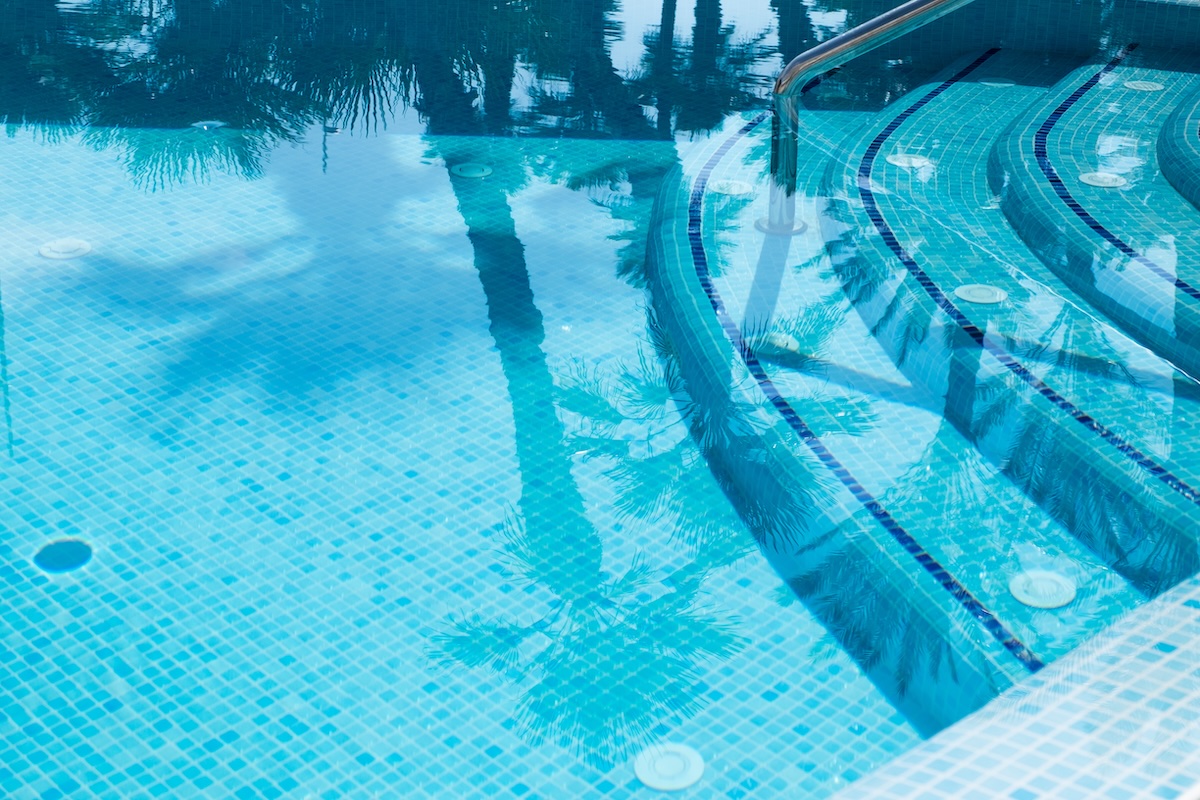
Keeping a pool clean and balanced doesn’t have to feel like a second job. Once you figure out a rhythm, it’s just a matter of regular upkeep. The alternative—green water and a swarm of mosquitoes—is definitely not worth it. So get out there, keep things circulating, brush away the trouble spots, and enjoy your pool the way it was meant to be: clear, clean, and inviting.
Professional Pool Cleaning Services (Las Vegas)
At Big League Pool Cleaners, we know pool ownership in Las Vegas comes with its own set of local pool maintenance challenges—from relentless sun exposure to hard water, and just about everything in between. That’s why our comprehensive services—including weekly pool cleaning, algae removal, chemical balancing, pool draining, filter cleaning, tile cleaning, and pool repairs—are designed to keep your pool in top condition all year long.
Whether you’re looking for regular pool maintenance or need help with a bigger issue, our team’s professional expertise will make sure you spend more time enjoying your pool—and less time worrying about it. Let us take care of the hard work for you.
Give Big League Pool Cleaners a call at 702-370-7715 or click here to contact us.

